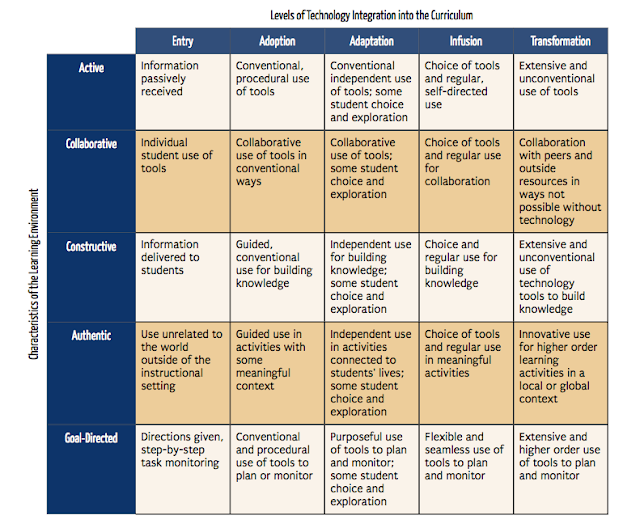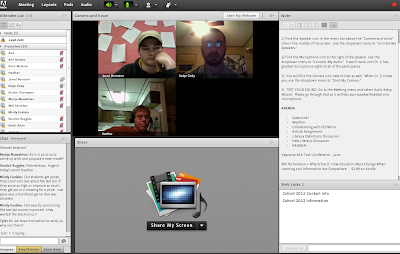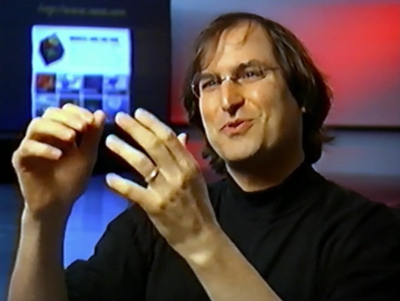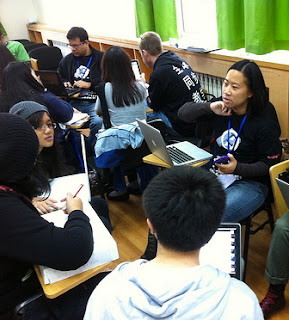 |
| flickr.com/schopie1 |
Integrating
digital technologies into your curriculum is much more than just adding
a computer to the lesson. Technology must be considered as a tool that
will support learning experiences. It must be selected based upon
pedagogical needs rather than the other way around.
Effective
learning involves challenging learners with situations that are
relevant to their lives and are challenging enough to interest them and
engage them in the learning process. When educators discuss levels of
intellectual challenge, they typically compare higher-order thinking to lower-order thinking. These terms are best described by using Bloom's Taxonomy.
Thinking Blooms
Bloom's
Taxonomy was first published in 1954 when Benjamin Bloom and his
colleagues wanted to create a hierarchy of terms that they could use
when they were describing various types of questions that they might use
on a test. Since then, the taxonomy has taken on a broader meaning
which educators used to also describe educational activities.
In
the 1990s, one of Bloom's students, Lorin Anderson, lead a group of
cognitive psychologists who reconsidered Bloom's taxonomy and reworked
it to reflect 21st century learning. You will notice that the new
taxonomy has changed the static verbs to active verbs by adding "ing" to
the end. They also removed Synthesis and placed Creating on the top.
This
tool has been aligned with 21st Century in many ways. Andrew Churches
in New Zealand has provided a digital perspective where he begins provides
Bloom's Taxonomy with a context and then identifies a number of digital
tools that can be grouped into each level.
Bloom's Taxonomy Blooms Digitally.
Churches demonstrates that the Higher-Order Thinking skills are the top
three verbs, Analyzing, Evaluating and Creating. The Lower-Order
Thinking skills are the bottom three verbs, Remembering, Understanding
and Applying.
Kathy Schrock and Samantha Penney have used a more graphical format to align Web 2.0 tools with the new version
of Bloom's Taxonomy. Kathy limits her work to Google tools while
Samantha expands it to a wide variety of Web 2.0 tools. Carefully review
these sites to provide a background for your later assignment.
Is
there any sense in classifying teaching strategies, questions, Web 2.0
tools using an organizer like Bloom's Taxonomy? Can pedagogical
activities actually be restricted to one of 6 classifications? Probably
not. Grouping tools like these are designed to provide vocabulary for
discussions between professionals. Using these classifications I can
distinguish teaching for memorization or developing problem-solving
skills.
Adding Technology to the Mix
Technology
can be used in a learning environment but will it make a difference? It
all depends on HOW technology is used. Like Bloom's Taxonomy,
technology can be integrated in a variety of ways. These may include
teachers who operate at a basic level by using PowerPoint presentations
to support their lecture-driven methods. They also include the teachers
who step back and encourage students to use these tools in innovative
ways to create new projects and experiences.
The
problem has been to find a vocabulary to define these various levels of
integration. Apple Computer sponsored a decade-long research project
entitled Apple Classrooms of the Tomorrow (ACOT). This project involved
providing technology-rich classrooms by filling them with Apple IIgs
computers AND providing one for each of the students' homes (20th
century 1:1 computing.) As they examined the various levels on which
teachers used technology, they identified a 5 stages including: Entry,
Adoption, Adaption, Appropriation, and Innovation. Read the article, What is Effective Integration of Technology, and Does It Make a Difference by Debra Rein.
It is a short article, but it provides a background for the ACOT
Evolution of Thought and Practice. Please note that these levels of
adoption exist in any teaching/learning situation whether it is in
corporate, PK-12 or post-secondary settings.
Watch this video on Edutopia and decide where each of the examples lie on the ACOT continuum.
SAMR - Substitute/Augment/Modify/Redefine
Another model that is popular in the schools today is the SAMR model. It was developed by Ruben R. Puentedura, Ph.D. to describe a ladder of implementation that occurs as you integrate technology into your curriculum.
Here is a video that describes the four levels of SAMR:
 |
| Dr. Ruben Puentedura, Ph.D. http://www.hippasus.com/rrpweblog/ |
Here is a video that describes the four levels of SAMR:
Did it make sense? Would you be able to identify and define the 4 levels of SAMR?
 If not, here is a Pinterest board that I found that is dedicated to SAMR. Did you find anything that better fit your learning style?
If not, here is a Pinterest board that I found that is dedicated to SAMR. Did you find anything that better fit your learning style?
How would you match the ACOT 5 stages and the SAMR model? Do they directly link to one another?
ACOT 5 Stages SAMR
Entry Simulation
Adoption Augmentation
Adaption Modification
Appropriation Redefinition
Innovation
 If not, here is a Pinterest board that I found that is dedicated to SAMR. Did you find anything that better fit your learning style?
If not, here is a Pinterest board that I found that is dedicated to SAMR. Did you find anything that better fit your learning style?How would you match the ACOT 5 stages and the SAMR model? Do they directly link to one another?
ACOT 5 Stages SAMR
Entry Simulation
Adoption Augmentation
Adaption Modification
Appropriation Redefinition
Innovation
Technology Integration Matrix (TIM)
The
key to successful integration requires a system to integrate the
research on Learning Environments with what has been learned about
technology adoption. In 2005, the Florida Department of Education created their Technology Integration Matrix (TIM).
This is a matrix that uses a series of 5 steps in technology adoption
that is similar to the ACOT set. It also has a set of desired learning
environment characteristics which include Active, Collaborative, Constructive, Authentic and Goal-Directed.
Go see TIM and play around for a while to see what they have to offer. You will even find some cells with video examples of lessons in a variety of subjects.
 | |
| http://fcit.usf.edu/matrix/download/tim_table_of_summary_indicators.pdf |
You will also want to visit the Arizona flavor of this matrix. It is essentially the same but it has video examples sorted by grade level. NOTE: My students like the Arizona TIM better than the Florida TIM. They have rewritten the descriptions and are easier to understand. They have sharp lesson plans that have been aligned with the Common Core state standards and provide assessments. It is a GREAT resource.
NOTE: I have been looking for such a matrix that displays this in a corporate training format, but to no avail.
Barriers to Technology Integration
Change
is not always easy. Even if an innovation can obviously improve
learning situations, there are a number of things that can get in the
way. In some cases it has to do with institutional barriers that get in
the way. Review (look for the highpoints) an article, Barriers to Adopting Emerging Technologies in Education by Rogers. This article looks at potential problems in the PK-12 as well as the University level schools.
Sometimes
the problem is in the attitudes and belief systems of the teachers.
This is another article which explores the Beliefs and Practices of
teachers in the ACOT study.
Changes in Teacher's Beliefs and Practices in Technology-Rich Classrooms by Dwyer, Ringstaff and Sandholtz
YOUR CHALLENGE:
Technology integration has many faces. The Entry levels of adoption are not bad to use in the classroom. Sometimes slideshows are the most efficient way to convey information. The key is to move deftly along the continuum to ensure that your learners are engaging into their learning experiences.
The key to using the matrix is to identify where your learning activities reside on the TIM. Are you in the Adoption-Collaborative cell? Are you in the Transformation-Authentic cell? This is not a perfect science but it is a way for you to examine what you are doing and provide it a label. Once you have identified what you are doing, you can then look for ways to move it it up the line.
Look at your teaching/learning/experiences and find 5 instances of technology integration in your special
field of interest. You may find these in your classroom, in the room next door, on videos, on
paper or ????? The key is that you consider this important to your field of teaching and it is worth your time to evaluate.
NOTE: Do NOT emphasize a technology tool. This challenge asks you to find an actual teaching/learning experience where a technology tool is used as part of lesson. The tool is not the center of this activity but rather what can be done using that tool.
NOTE: Do NOT emphasize a technology tool. This challenge asks you to find an actual teaching/learning experience where a technology tool is used as part of lesson. The tool is not the center of this activity but rather what can be done using that tool.
Spend a little time and evaluate it by:
- Describing the example including level, subject, intended outcome and process.
- Identifying the cell on the TIM into which it would be classified.
- Explain why you classified it into that cell. What are the attributes that cause it to fit into that section?
- Explain how this would fit into your world of teaching/learning. How would/could you use it in your classroom? If you don't have a classroom yet, then place it into the classroom where you intend to work.
BAM!!!! Take it up a notch.
Select 3 of your examples
and consider how you would reorganize this lesson to move it to another
level. This means that after you have identified the cell where one
specific lesson's activities exist, you will identify changes you could
make in how you are designing the lesson's activities to move it to
another cell that is "Up a notch." You MUST identify the specific
coordinates of the cell where you are moving the lesson.
Now that you know where you are, let's do some traveling.
- The Characteristics are not in any sequence, so how would you take it to another characteristic?
- The Technology is in a sequence so you will need to move it to the right. Moving it to the right requires you, the teacher, to relinquish some control to your students. It is a process that allows your students to take on greater roles as problem-solvers.
What Should I Do?
Not that you have done this work, what should you do with it? Use it!!! You have made a change in your teaching strategies, so use it.
Want a place to share your ideas? Add them as a comment to this post.
I hope that this is will be the beginning of a series of writings that I will share here and in the future.
Please respond and give me feedback about how you are using the TIM to help you expand your teaching.
Z









